Last Updated on May 25, 2025 by Owen McGab Enaohwo
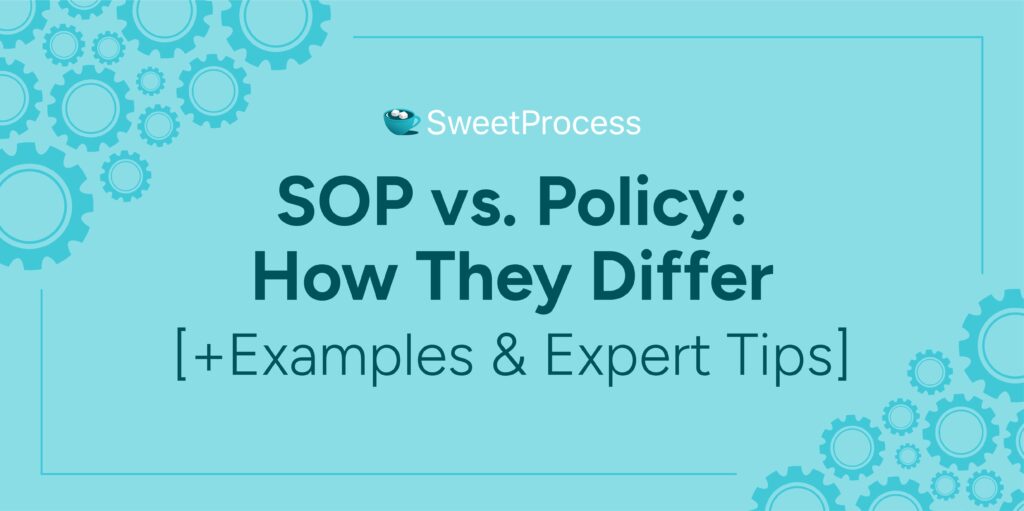
Running a business means juggling a hundred moving parts at once. A new hire needs training, a customer files a complaint, an order gets delayed, and suddenly, everyone’s scrambling.
Who handles what? What steps should they follow? That’s where standard operating procedures (SOPs) and policies come in.
When harmonized, these documents clarify what should be done, who does a task, and when the task should be done. Fragmentation, or the absence of both, can result in misaligned goals or, even worse—compliance issues. For example, in 2010, GSK faced a $750 million fine after its Puerto Rico plant was found to have serious manufacturing failures, including cross-contaminated medications, bacterial contamination, and improper quality control—issues that stemmed from inadequate SOPs and policies for production oversight, sanitation, and regulatory compliance.
We’ll cover the major differences between these two important documents, why and when you need each, and how to create them for your organization.
Ready to simplify how you document and manage your organization’s SOPs and policies? Sign up for a 14-day free trial of SweetProcess. No credit card needed.
Table of Contents
What Is a Standard Operating Procedure?
Standard Operating Procedure vs. Policy: How Are They Different?
How To Write a Standard Operating Procedure
SOP vs. Policy: Examples To Inspire Your Team
How To Manage Your Company’s SOPs and Policies Using SweetProcess
When Do You Need SOPs Over Policies and Vice Versa?
What Is a Standard Operating Procedure?
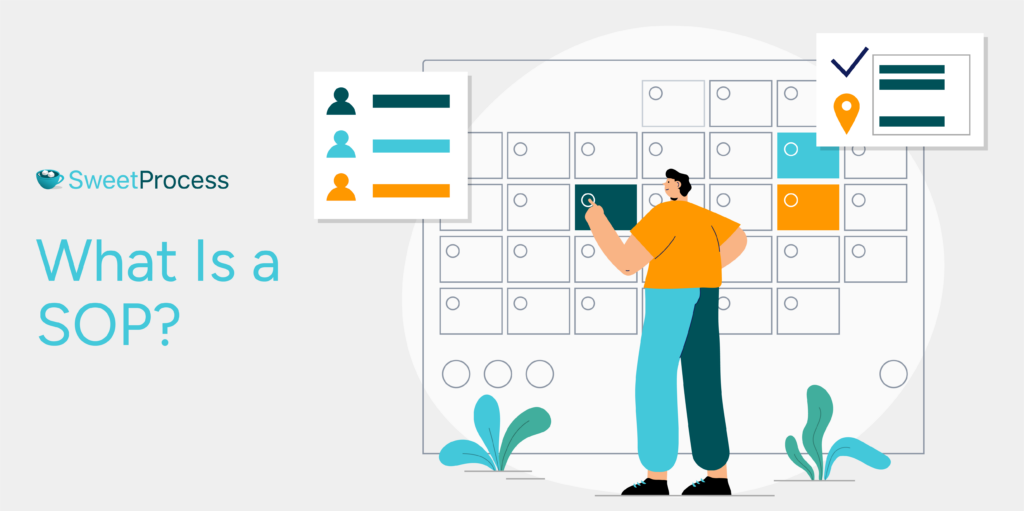
A standard operating procedure (SOP) is an instructional document outlining how to perform a specific organizational task or process. Think of an SOP as a step-by-step recipe book with precise directions for employees that, when followed correctly, produce consistent results every time.
For example, a restaurant might have an SOP for opening the store each morning. This document would detail each step: opening at a specific time, turning on equipment in a particular order, preparing workstations according to food safety guidelines, and conducting inventory checks. Each step would include specifics like “Preheat ovens to 350°F for 15 minutes before the first order.”
SOPs are invaluable because they:
- Ensure consistency in execution regardless of who’s performing the task
- Reduce training time for new employees
- Minimize errors and quality issues
- Support compliance with regulations and standards
- Protect organizational knowledge when employees leave
According to Sarah Brenner, director of quality assurance at Belvidere Community Unit School District 100, who uses SweetProcess for documenting SOPs at Belvidere, “If an individual left the organization, there was no way to know what their process was before or to have access to that information. This is a mechanism that is now being met by departments. We have an HR folder and a finance folder. The administrators, the teachers, or the clerical can go in and see: ‘Oh, do we have something regarding this?’”
What Is a Policy?
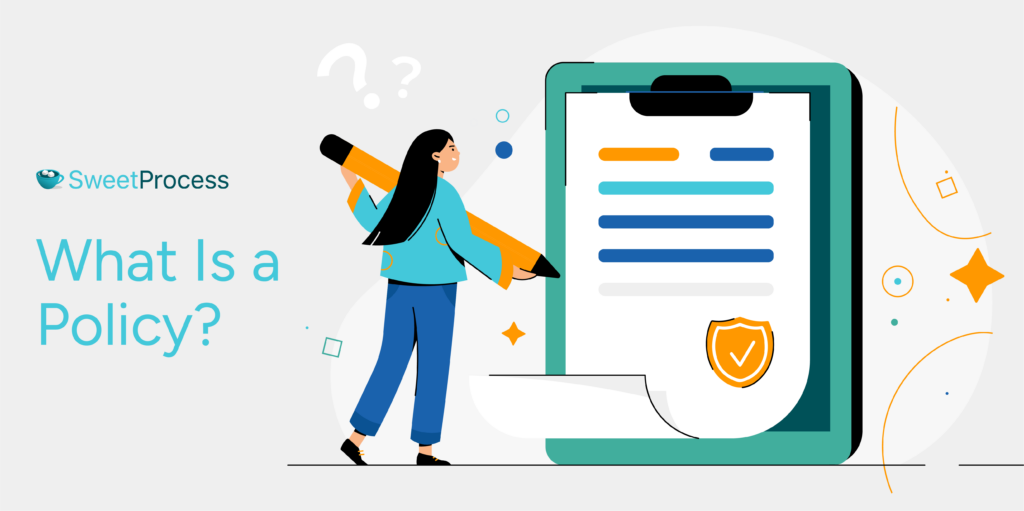
A policy is a high-level directive communicating the principles, rules, and guidelines that govern an organization’s actions. Unlike the detailed “how-to” nature of SOPs, policies focus on the “what” and “why” of organizational behavior and decision-making.
For example, a company might have a remote work policy outlining:
- Eligibility criteria
- Expectations for availability
- Equipment usage rules
- Security requirements
While it states what is allowed or prohibited, it doesn’t include step-by-step instructions for setting up a home office or connecting to the VPN—all those details should appear in related SOPs.
Policies are needed when running a business to:
- Provide a framework for consistent decision-making
- Establish clear expectations for behavior and performance
- Ensure legal and regulatory compliance
- Reflect and reinforce organizational values
- Create accountability at all levels of the organization
Standard Operating Procedure vs. Policy: How Are They Different?
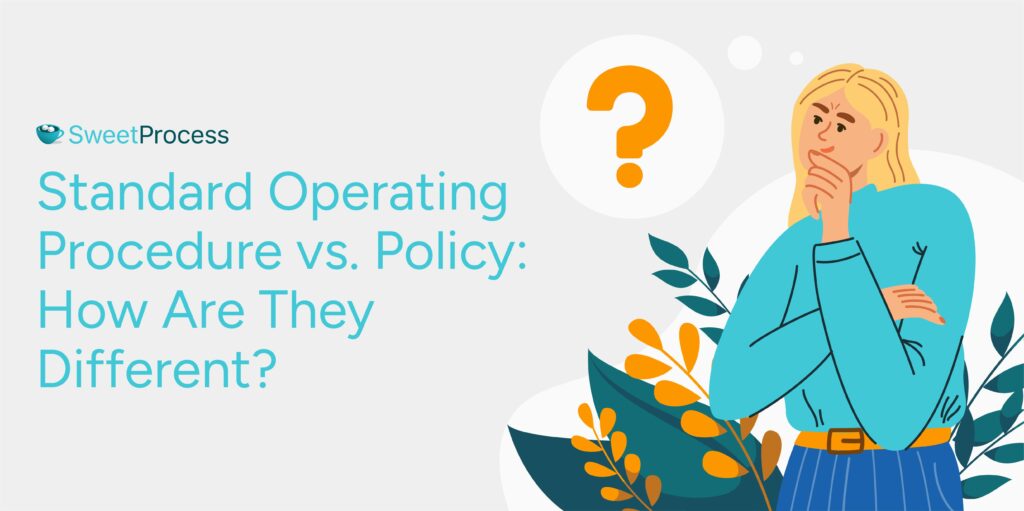
While SOPs and policies guide organizational behavior, results, and potential outcomes, they differ fundamentally in several ways.
1. Level of Detail and Specificity
SOPs: Highly detailed, with step-by-step instructions for a specific task
Policies: Broad guidelines outlining general principles and expectations
SOPs are detailed, step-by-step instructions that explain exactly how to perform a particular task or process. Policies, however, are broad, high-level guidelines that establish boundaries and expectations. They typically focus on what should be done and why without detailing the specific steps.
“If it’s a big-picture rule that won’t change often, it’s a policy. If it’s a detailed business process that might evolve, it’s an SOP. We once had a field trip policy that outlined all the guidelines, but the actual process of booking transportation and handling expenses was better suited for an SOP.” —Tawny Lott Rodriguez, Human Resources Director at Rowland Hall, Salt Lake City, UT
2. Purpose and Scope
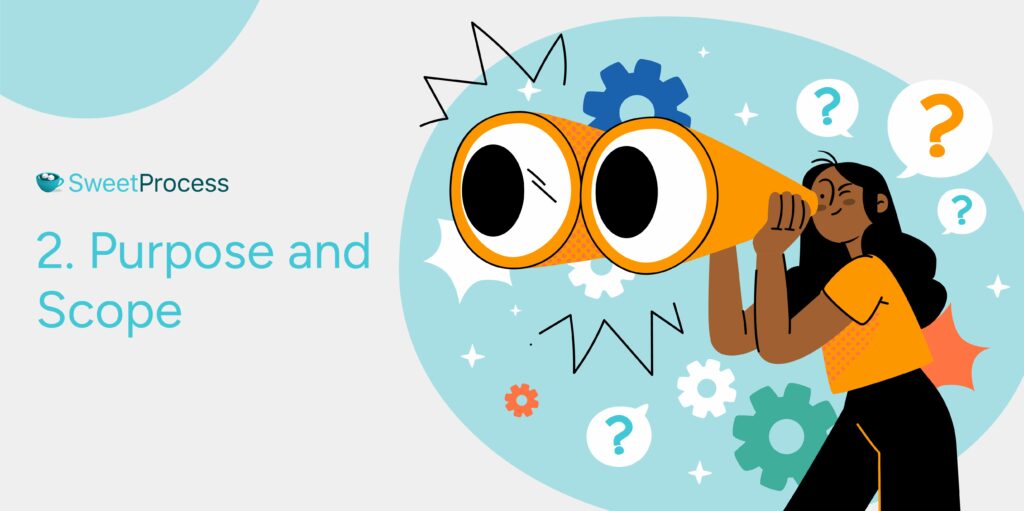
SOPs: Standardize routine operations to ensure consistency and quality
Policies: Establish the organization’s stance on various issues and guide decision-making
SOPs ensure operational consistency and efficiency by focusing on execution and process standardization. Policies, however, establish the rules, principles, and intentions of an organization.
3. Applicability
SOPs: Applied to specific processes or tasks within departments
Policies: Applicable organization-wide, influencing overall conduct and culture
SOPs are often specific to particular roles, functions, or processes. In some cases, they may only apply to certain employees or situations. Policies typically apply organization-wide or to entire departments. In other words, they set general expectations.
“At Swapped, we once had a policy that all customer withdrawals must go through a fraud check. At first, that was enough. Then, we ran into cases where someone would flag a transaction but had no clear process to escalate it. We turned that into an SOP detailing steps for verification, approval, and communication. Fraud checks became faster, and the team stopped second-guessing decisions.” —Thomas Franklin, Founder & CEO, Swapped.com.
4. Flexibility
SOPs: Require strict adherence to ensure uniformity
Policies: Allow for interpretation and discretion in their application
SOPs leave minimal room for deviation. They prescribe specific actions to be taken in a particular order. Policies, on the other hand, provide guidelines that may allow for some interpretation or judgment within defined boundaries.
5. Hierarchy
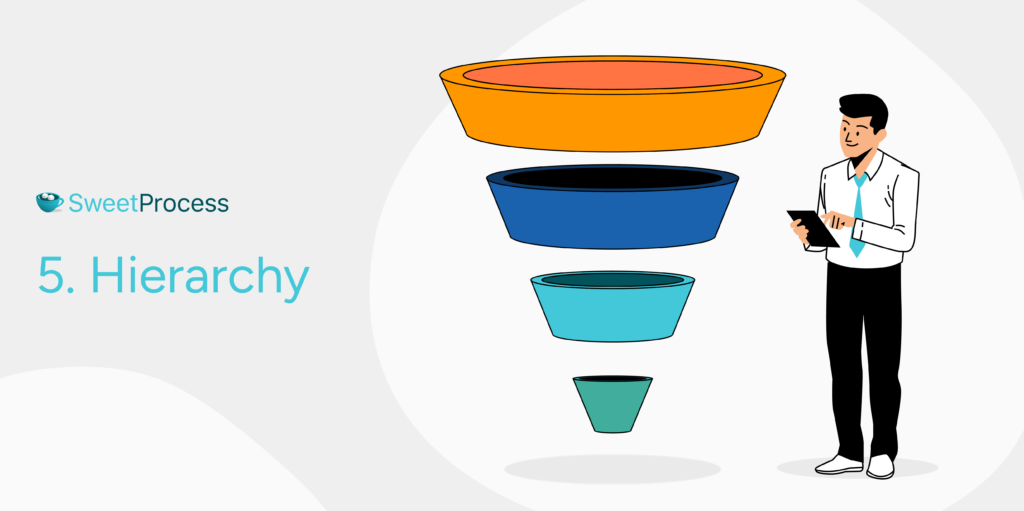
SOPs: Operate under the umbrella of policies by detailing how to implement policy directives
Policies: Serve as the foundational guidelines from which SOPs are developed
SOPs must align with and support relevant policies. In other words, SOPs are subordinate to policies and translate policy requirements into actionable steps. Policies sit at a higher level in the documentation hierarchy.
According to Maurizio Petrone, founder & CEO at PressHERO,
“In determining what belongs where, I use the ‘rule vs. method’ test. For instance, our content creation guidelines started as a lengthy policy document but evolved into two distinct pieces: a policy stating our content standards (no plagiarism, fact-checking requirements, brand voice guidelines) and an SOP Format detailing the actual content creation process.
“When it comes to review cycles, our SOPs typically require updates every quarter as we optimize processes, while policies usually stay stable for a year or more. For example, our link-building SOPs have been modified six times in the past year as we discovered more efficient outreach methods, but our quality standards policy remained unchanged.
“One of our biggest successes came from combining a clear communication policy with detailed SOPs for client interactions. The policy established response time expectations and communication channels, while the SOPs provided templates and workflows for different types of client requests. This combination reduced response times by 40% and improved client satisfaction scores.”
6. Compliance
SOPs: Ensure compliance with policies and regulatory requirements through detailed procedures
Policies: Ensure the organization meets legal and ethical standards
SOPs focus on internal standards and best practices. While they may support compliance management efforts, they’re primarily about operational excellence. Policies often directly address legal, regulatory, or industry standards. Non-compliance can have significant consequences.
7. Relevance
SOPs: Focus on operational efficiency and task execution
Policies: Focus on governance, risk management, and organizational values
SOPs may change more frequently as processes evolve, technologies change, or improvements are identified. Policies tend to remain relatively stable over time, though they require periodic review and updates.
“Policies rarely change unless laws or company values shift. SOPs, on the other hand, evolve constantly. Our fraud detection policy has stayed the same since day one, but the SOP has been updated 11 times in the last two years. New threats mean new procedures. A business that fails to update SOPs will always fall behind.”
—Shane Lucado, Founder and CEO, InPersuit
8. Audience

SOPs: Target employees performing specific tasks
Policies: Target all members of the organization
SOPs are primarily written for internal use by the employees who perform the specific procedures. Policies are often written for a broad audience and may be shared with external stakeholders, including regulators, customers, or partners.
9. Strategic Position
SOPs: Tactical tools for daily operations
Policies: Strategic tools for long-term planning and decision-making
SOPs focus on tactical execution and excelling in operational efficiency rather than strategic positioning. Policies align closely with organizational strategy and values. They reflect the company’s position on important issues.
10. Adaptability
SOPs: May require frequent updates to adapt to process changes
Policies: Typically more stable, with infrequent revisions
SOPs are designed for consistent application in specific, defined scenarios with little adaptation. Policies provide a framework that can adapt to various situations through interpretation within defined boundaries.
According to Lucas Botzen, CEO of Rivermate,
“One of the main challenges to the adherence of team members to policies as opposed to those of SOPs was engagement and accessibility. Policies are commonly viewed as hard laws, whereas SOPs are sometimes regarded as too bureaucratic. Also, stakeholders interact differently with these documents: the executives and compliance officers see policies from the point of view of mitigating legal and operational risks, while the frontline workers consider SOPs for their effectiveness in achieving daily tasks.
“To close the gap, we brought together interactive training modules and microlearning sessions to ensure that employees understand the policies and know where to find them and use various SOPs. The introduction of visuals, process maps, and video tutorials noticeably contributed to adherence and a reduction in procedural errors.”
How To Write a Standard Operating Procedure
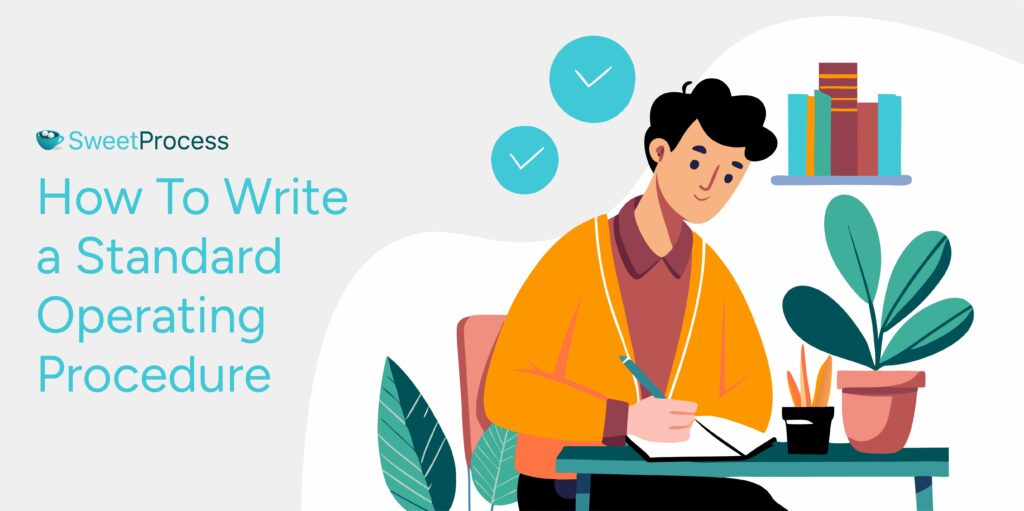
Unlike policies, which establish guiding principles, SOPs must provide clear and actionable instructions. When creating an SOP, it’s essential to involve frontline employees in the development process. Their firsthand experience will ensure that the procedures are practical and relevant.
Let’s take a quick look at how to write a standard operating procedure:
1. Define the Purpose: Clearly state the objective of the SOP and its intended audience
2. Gather Information: Consult subject matter experts and relevant documents to ensure accuracy
3. Structure the SOP: Use a consistent format, including a title, scope, responsibilities, and step-by-step instructions
4. Write Clear Instructions: Use concise, action-oriented language, avoiding ambiguity
5. Include Visual Aids: Add flowcharts, diagrams, or checklists to enhance understanding
6. Review and Revise: Seek feedback, test the procedure, and refine as needed
7. Get Approval: Ensure management or compliance teams sign off on the SOP
8. Distribute and Train: Share the SOP with relevant personnel and provide necessary training
9. Monitor and Update: Regularly review and revise the SOP to keep it current and effective
How To Write a Company Policy
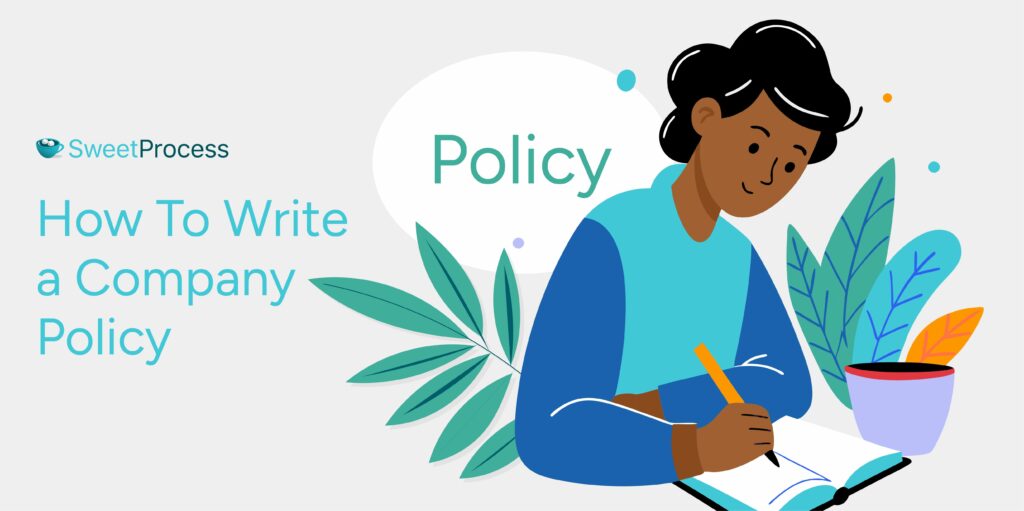
While SOPs focus on specific processes and tasks, policies establish the foundational rules and principles that guide organizational decision-making.
Developing a company policy involves identifying its needs, consulting with stakeholders, drafting clear and concise guidelines, and ensuring alignment with legal and ethical standards. Unlike SOPs, policies require a broader perspective to encompass the organization’s values and strategic objectives.
Here are the steps to creating a policy for your company:
1. Perform Internal Research: Assess existing policies, company objectives, and stakeholder concerns to ensure alignment
2. Identify Necessary Policies: Determine key areas such as HR, cybersecurity, or workplace safety and prioritize them based on urgency
3. Include Key Elements: Define the policy’s purpose, scope, responsibilities, statements, guidelines, and compliance measures
4. Develop Clear Content: Write concise, jargon-free content that aligns with company culture and ensures easy comprehension
5. Clarify for Stakeholders: Provide FAQs, examples, or supplementary materials to improve understanding and application
6. Review and Format: Gather feedback, refine content, and structure the document for clarity and readability
7. Approve and Publish: Obtain necessary approvals, then communicate the policy through multiple channels for company-wide awareness
SOP vs. Policy: Examples To Inspire Your Team
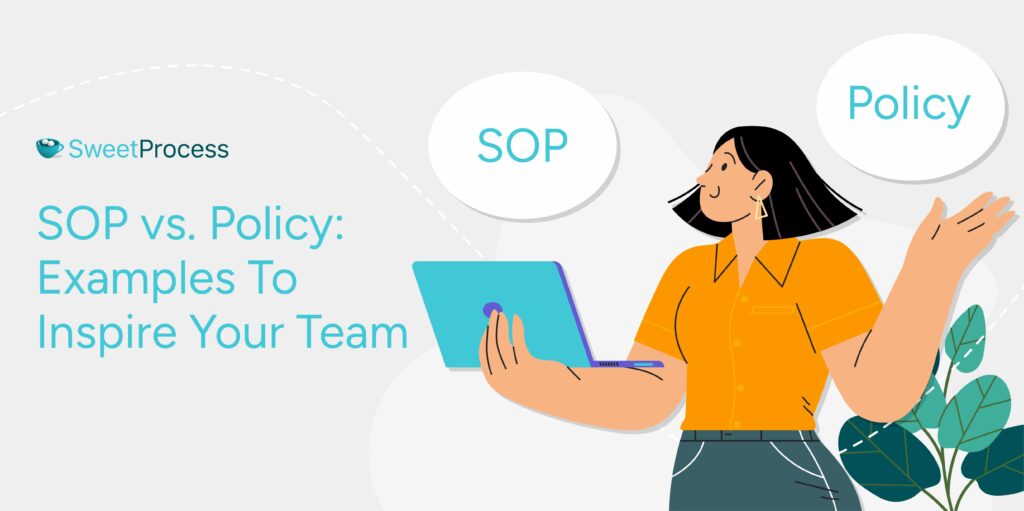
Below are some examples created in various contexts to give you inspiration for your own documentation.
SOP Examples To Create Using SweetAI
Let’s go over a few SOP Examples. Remember you can create SOPs using our SweetAI tool:
1. Human Resources SOP for Hiring Employees
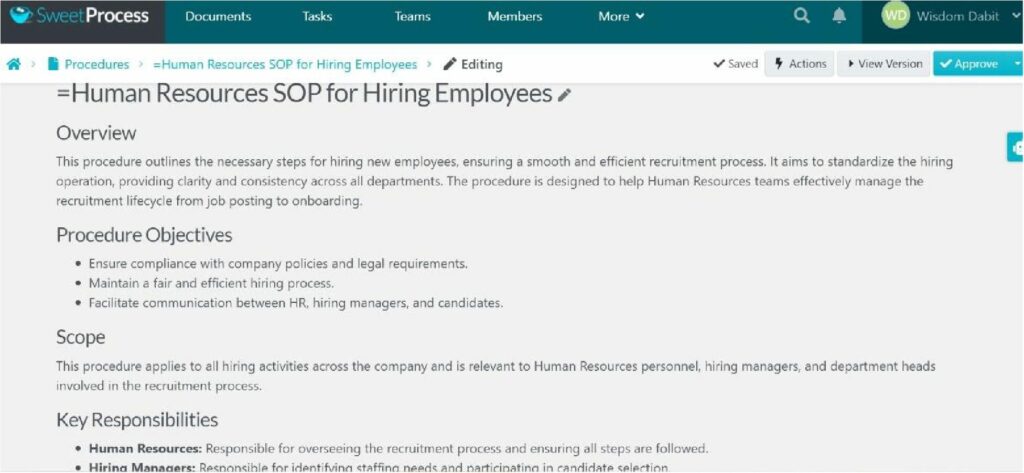
This type of SOP is used to guide the whole process of attracting, selecting, and onboarding new hires to carry out day-to-day activities in a company. It’s the playbook for getting the right people who can execute ideas and ensure the mission and goals of the business are achieved.
2. Blog Publishing SOP
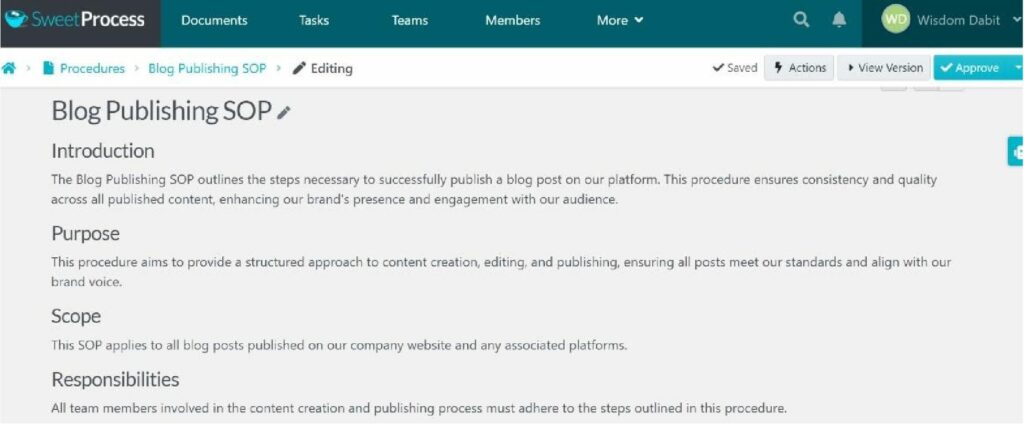
A Blog Publishing SOP ensures consistency in tone, style, and quality across all blog content. It typically outlines the steps for researching, writing, editing, publishing, and promoting blog posts to increase website traffic. Using tools like SweetProcess can simplify the creation and management of such SOPs. For example, SweetProcess allows you to document procedures manually or automatically using SweetAI, ensuring streamlined workflows and easy updates. These sop examples demonstrate how businesses can maintain efficiency by centralizing and managing processes effectively
3. Customer Service SOP
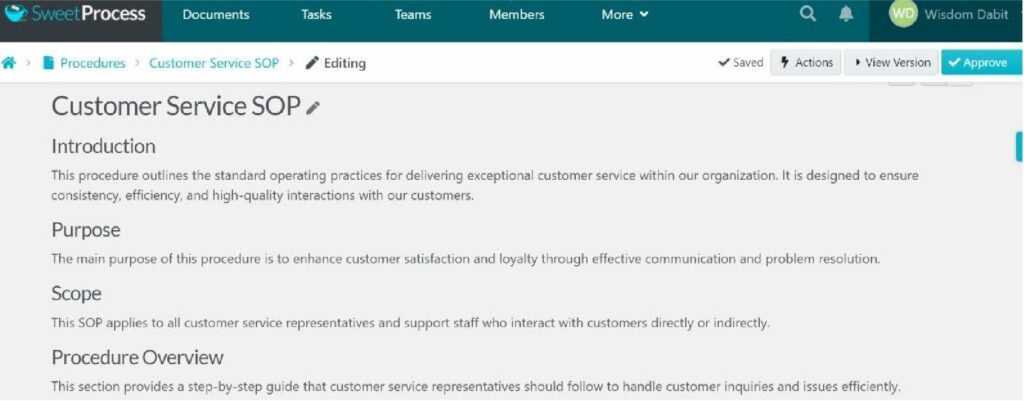
This is a customer-focused SOP for resolving customer complaint issues on time to ensure there are or no bad reviews, or even slow response times to inquiries. It normally covers topics like effective issue resolution, troubleshooting procedures, and communication channels to use — whether email, phone, or text.
Policy Examples To Create Using SweetAI
If you need internal policies for your company, there’s no need to start from scratch. It’s super easy to write policies with our built-in SweetAI tool. Here are three examples:
1. Recruitment Policy
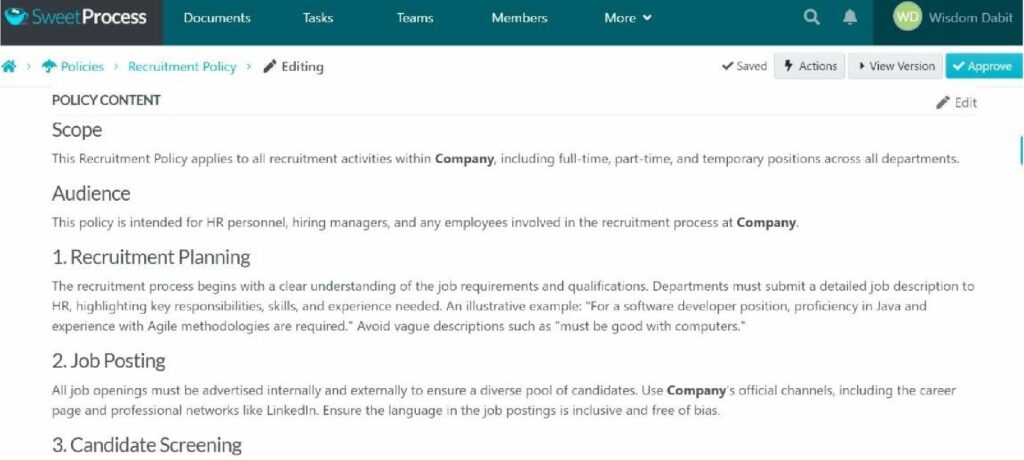
The Recruitment Policy normally lays down the criteria for recruiting and hiring new employees into a company. It briefly covers policies on areas like job posting, candidate screening, recruitment planning, and new hire onboarding. Plus, the skills and experience the job applicants are expected to have.
2. Work From Home (WFH) Policy
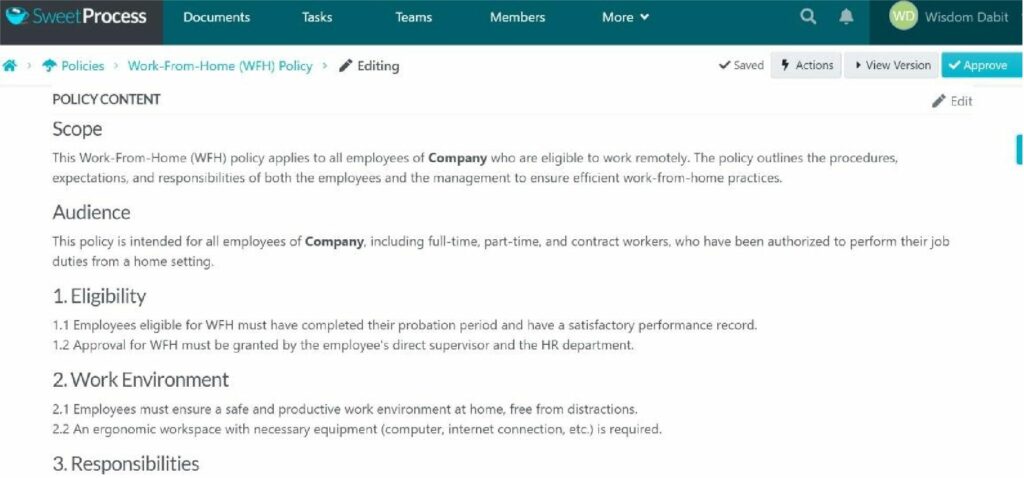
This policy is mainly used in organizations that employ remote workers. The WFH Policy outlines the organization’s guidelines and expectations for employees working from home. It states the eligibility criteria, work hours, responsibilities, equipment, and software requirements to ensure that everyone actively plays their role.
3. Internal Communication Policy
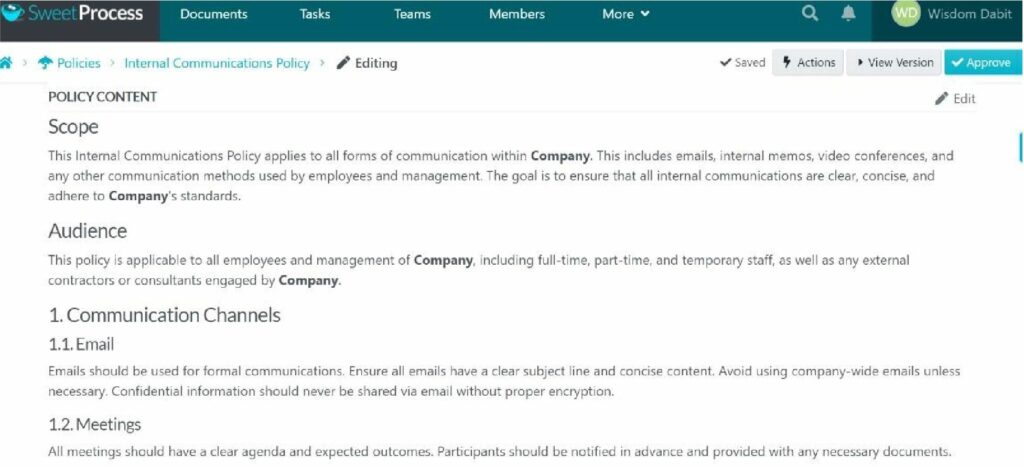
The Internal Communication Policy typically shows the company’s guidelines for proper and effective communication. It consists of channels for internal communication and the rules for email and team meetings, to ensure everyone is on the same page.
To create efficient and organized policies and SOP documents, try SweetProcess free for 14 days and experience the ease.
How To Manage Your Company’s SOPs and Policies Using SweetProcess
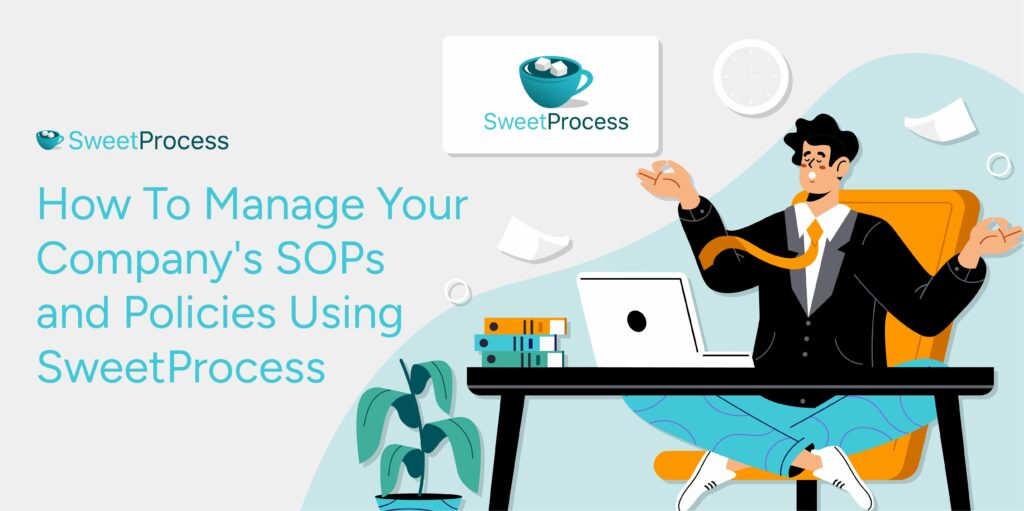
SweetProcess offers a comprehensive solution to create, manage, and distribute your policies and SOPs.
Manage Your Company’s Policy
Businesses often struggle with disorganized policies, which create chaos, inconsistencies, operational errors, and bad customer experience. To help your staff easily find your policy guides for every operational step, you can use SweetProcess to set it up.
Here’s how to efficiently manage your company’s policies with our tool:
Go to the “Policies” tab and click “Create Policy.”

Add a title, write the policy content, and click “Approve.”

To categorize policies, click on the three dots beside it.

Then select “Teams.”

Assign it to a relevant team (e.g., customer support, HR, marketing, finance, etc.).

To track changes, click the clock icon on the left or use the Policy Activity function.

You can share the policy with your teammates by clicking the three dots next to the document.

You can even share or export policies as PDFs or print them.

Many brands have used our SOP software to document their policies and SOPs, like the managing director at All Residential Real Estate, Perry Beebe, who is responsible for managing properties for his clients.
Initially, their paper-based checklists were ineffective in meeting the documentation needs. They were easily outdated and left team members with inadequate information that prevented them from working efficiently.
In a bid to improve their SOPs and increase staff efficiency, Perry tried creating paperless documentation with different software but didn’t get his desired results.
“I started searching for software online that would be able to meet our requirements,” Perry said. “I went through a series of different providers like Trello and Monday. There’s a series of software that other companies were using, but primarily they’re project-based, and what we needed was procedure-based software that had the software equivalent of doing checklists.”
In the course of his search, he discovered SweetProcess, and today, here’s what he has to say:
“If you’re working in a procedural-based business, have a look at SweetProcess. Have a look at the procedures and policies within SweetProcess and see how you could create those sorts of systems in SweetProcess.”
If you want to improve SOPs in your business, you can use our software for up to 14-days free. No need to add a credit card, and if you aren’t impressed with the software at the end of your trial, you can simply walk away.
Manage Your Company’s SOPs
One major challenge companies face is disorganization and inefficiency from having SOPs scattered across multiple files or buried in Word documents. As a result, employees spend precious time struggling to follow daily processes.
Luckily, SweetProcess removes the hassle. It gives you one place to create, store, and manage your SOPs so your team can work smoothly and efficiently.
Here’s how:
Go to the “Procedures” tab under the “More” menu and click “Create Procedure.”

Add a title.

To organize it, scroll down and click “Teams” to assign the SOP to a team.

View version history by clicking the clock icon on the left side.

To export, edit, duplicate, request sign-off, or share, click the three dots beside the SOP document.
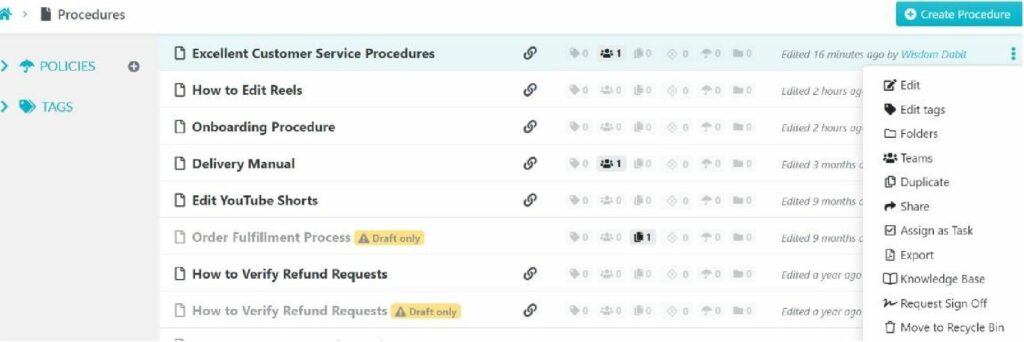
Turn SOPs and Policies Into a Knowledge Base
Even when companies compile SOPs into documents and Word files, there’s a tendency to spend time searching for a particular process guide.
However, SweetProcess allows you to turn your SOPs and policies into a searchable knowledge base, so your employees don’t have to struggle with locating company documents. If you want to stop answering the same FAQs repeatedly, simply convert your SOPs and policies into a knowledge base with SweetProcess.
Here’s how to do it; go to the “Procedures” or “Policies” section.

Select the document you want to convert and click the three dots on the right side.

Choose “Knowledge Base.”

Click “Add Knowledge Base” and “Approve” to save.

Easy! With SweetProcess, managing policies and SOPs is effortless.
Take a look at Amy Walls, the president and financial advisor at Thimbleberry Financial, who created business SOPs in Microsoft Word documents to improve their operations. However, her team kept struggling to access the information they needed to perform tasks.
Even after Amy’s business coach recommended SweetProcess, she was reluctant—until she saw the results.
“Our new employees say they have never gone through a more organized onboarding. We have one or two SweetProcess procedures that they work through. They start on their first day. When they start, we literally have them get access to three things. One is their email. One is SweetProcess, and one was our Slack channel, but now it’s Teams,” Amy says excitedly.
Collaborate Seamlessly With Team Members
Not having the chance or a platform to share ideas while creating, updating, and executing SOPs? Sadly, most companies rely on emails to collaborate, and this often leads to project delays and workplace disputes.
But with a tool like SweetProcess, you don’t have to deal with this. Collaborating with your team becomes simple and efficient.
To share a policy or SOP for feedback:
Head to the “Processes” tab.

Click on the three dots of any document.

An options menu will display to enable you to assign the document as a task, share it, or ask someone on your team to sign it off.

If you want a team member to communicate their thoughts about a policy or SOP knowledge base document, head to the “Knowledge Bases” on your menu.

Select the “Ask your team members for feedback at the end of each article” option to activate the comment feature.
Voila! Your team members can easily give their opinions on a process document.

When Do You Need SOPs Over Policies and Vice Versa?
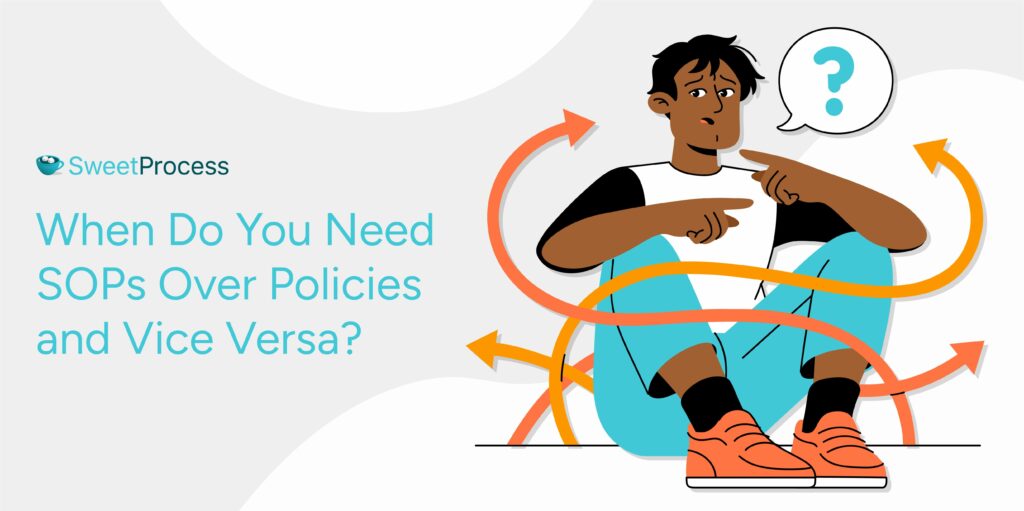
When To Develop Policies
- When establishing foundational rules: Policies should be created first when setting up organizational governance.
- For compliance requirements: When addressing regulatory obligations that apply across the organization.
- When defining organizational positions: Use policies to articulate your company’s stance on important issues like sustainability, diversity, or customer service.
- For risk management: Policies can help you mitigate risks by establishing boundaries around high-risk activities.
- During organizational changes: Major transitions like mergers, reorganizations, or strategic pivots often require new or updated policies.
When To Develop SOPs
- For complex, repeatable processes: Processes with multiple steps that must be performed consistently benefit from SOPs.
- During training initiatives: SOPs provide excellent training materials for new employees learning specific job functions.
- After policy implementation: Once policies establish what should be done, SOPs can detail how to do it.
- For quality control: When consistency is crucial for product or service quality.
- When knowledge preservation is critical: SOPs capture procedural knowledge that might otherwise be lost when employees leave.
- During process optimization: Creating an SOP often reveals inefficiencies and continuous improvement opportunities.
When You Need Both Working Together
In many cases, policies and SOPs work as complementary documents. For example:
- A data security policy establishes rules for protecting sensitive information, while associated SOPs detail the specific steps for secure data handling, breach response, and access control.
- A customer service policy outlines commitments and standards for customer interactions, while SOPs provide specific procedures for handling inquiries, complaints, and service requests.
- A workplace safety policy establishes the organization’s commitment to employee well-being, while SOPs detail specific safety protocols for various work environments and situations.
SOP vs. Policy: Key Takeaways
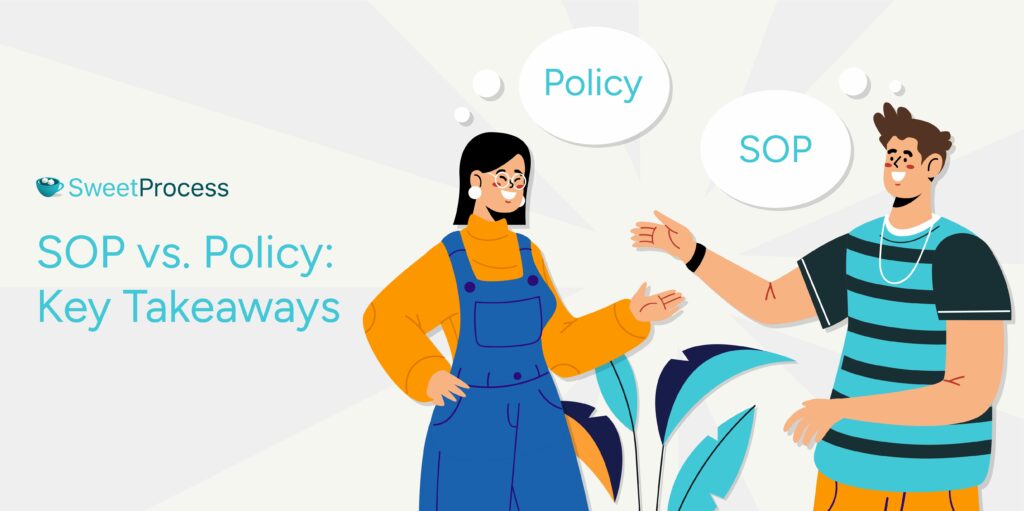
In summary, here are the key distinctions in a tabular form:
| Characteristic | Policy | SOP |
| Purpose | Establishes rules, principles, and guidelines | Provides detailed instructions for specific tasks |
| Focus | What and why | How |
| Detail Level | High-level, broad guidelines | Detailed, step-by-step instructions |
| Scope | Organization-wide or departmental | Process or task specific |
| Format | Narrative, principles based | Structured, sequential steps |
| Flexibility | Allows for interpretation within boundaries | Minimal room for deviation |
| Change Frequency | Relatively stable, periodic reviews | May change as processes evolve |
| Primary Audience | All stakeholders, including external parties | Employees performing specific functions |
| Ownership | Executive leadership, board, compliance | Department managers, process owners |
| Compliance Focus | Legal and regulatory requirements | Operational standards and best practices |
Policies and procedures are important in any organization, but they serve distinct purposes and follow different structures. Writing an SOP isn’t the same as drafting a company policy and vice versa; knowing these differences can help you create both more effectively.
The best part? With SweetProcess, you can easily document and manage SOPs and work instructions that enhance efficiency across your business.
